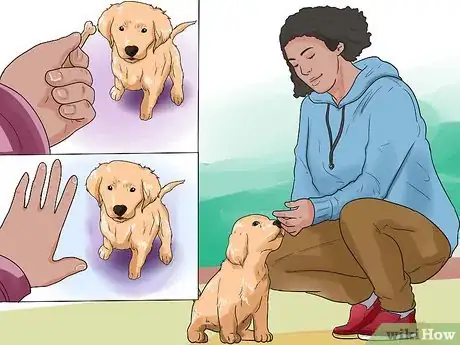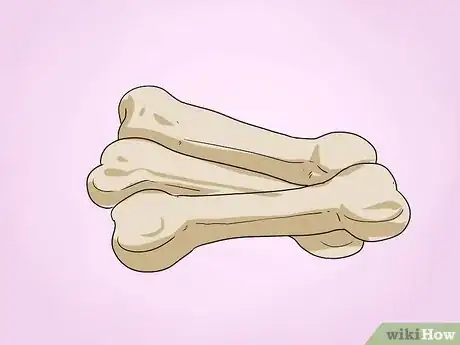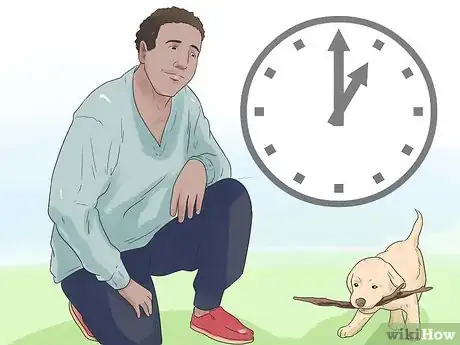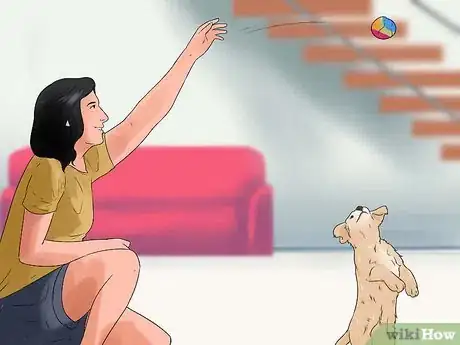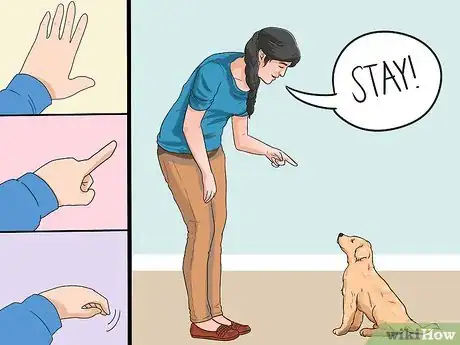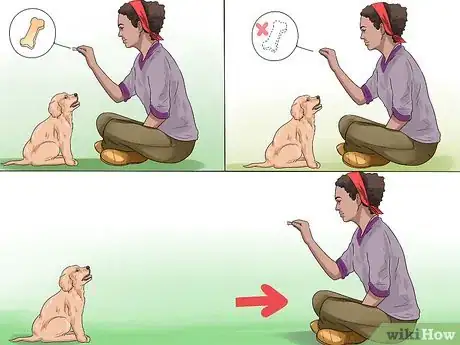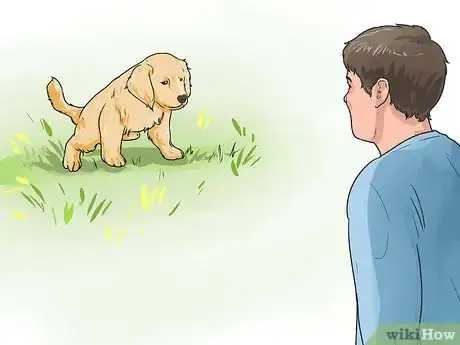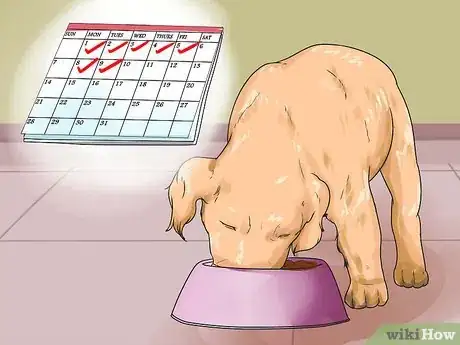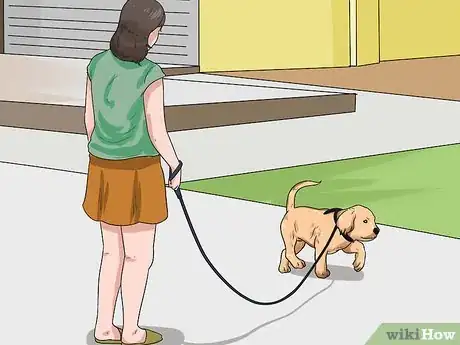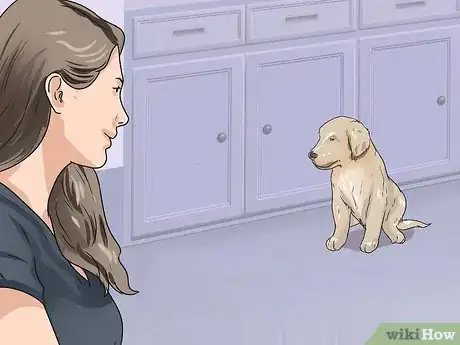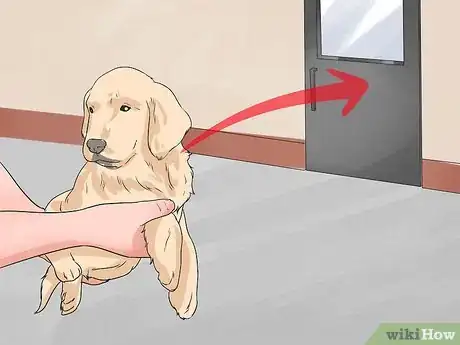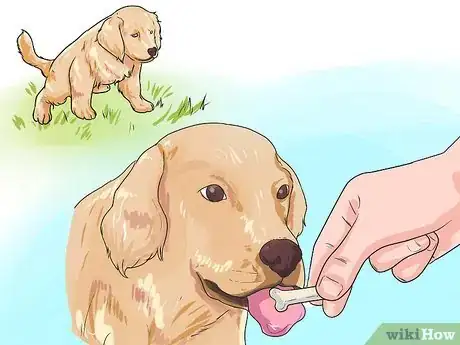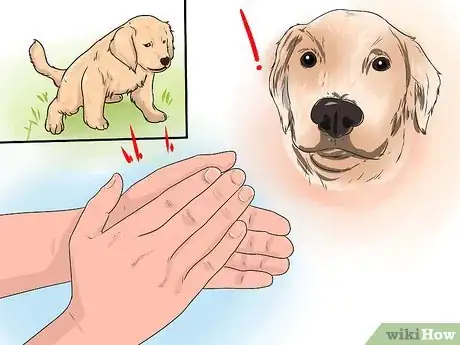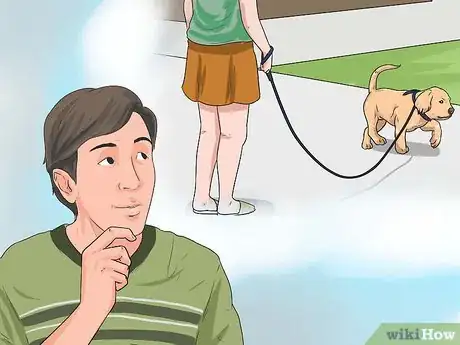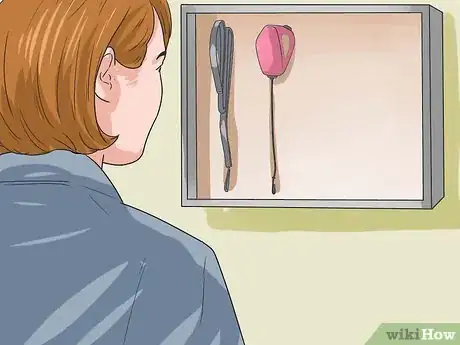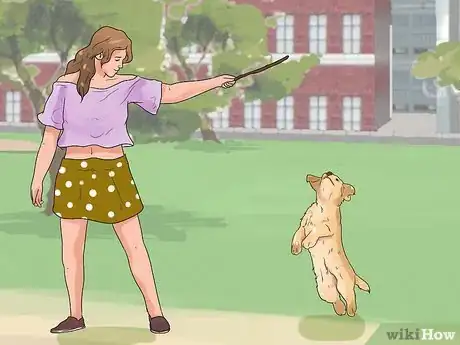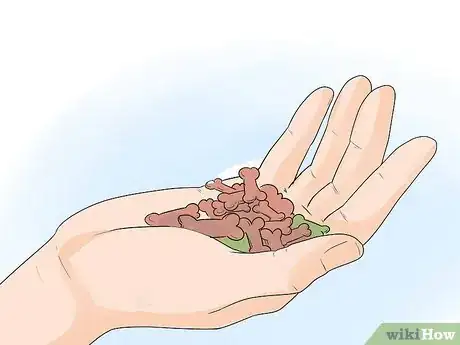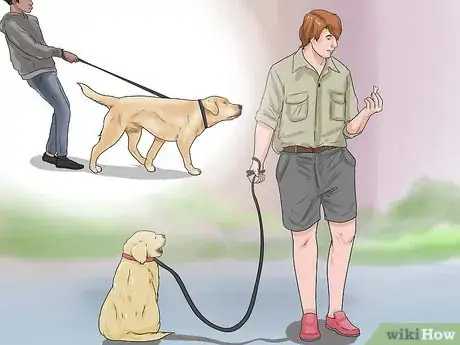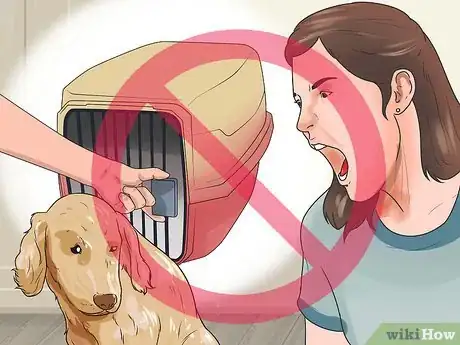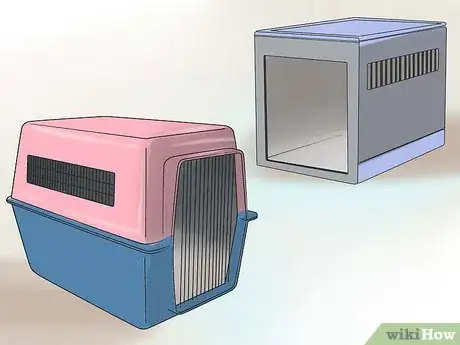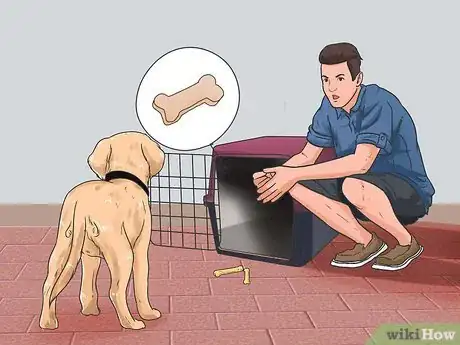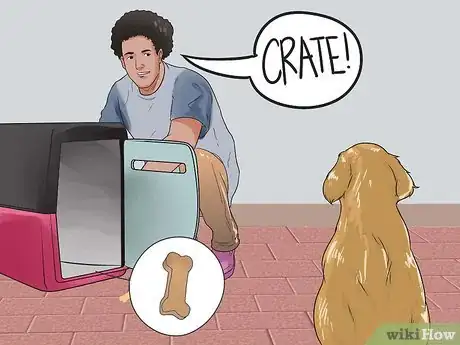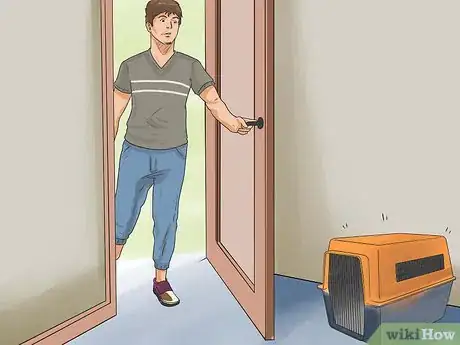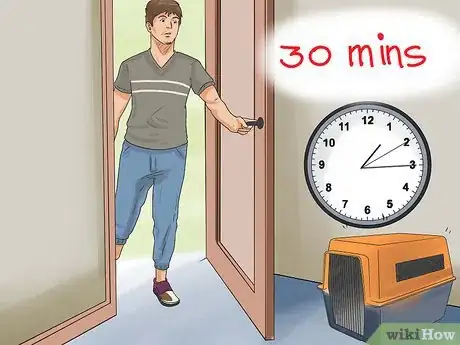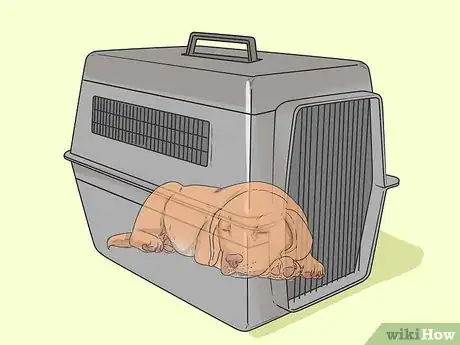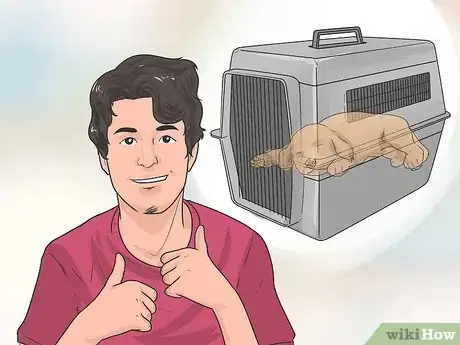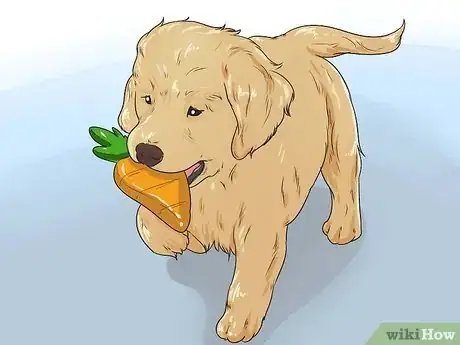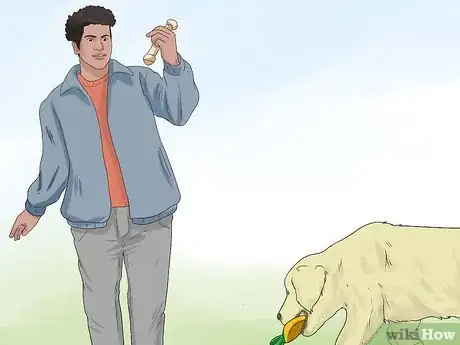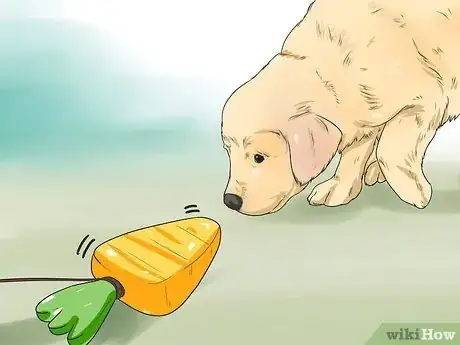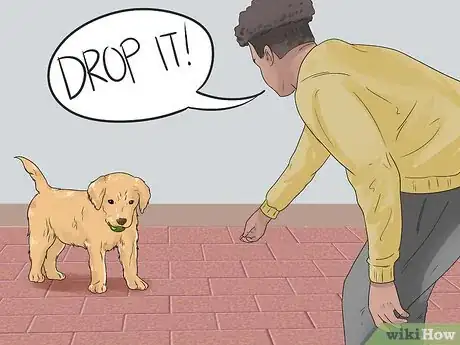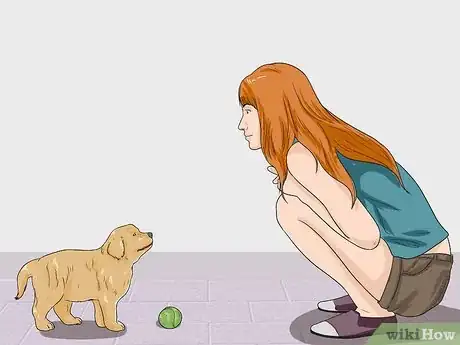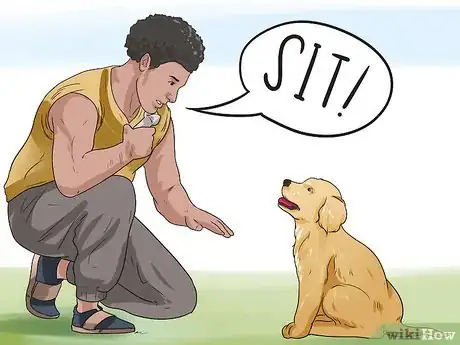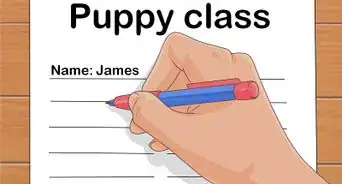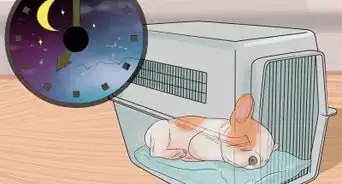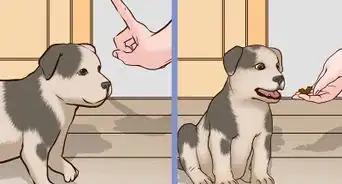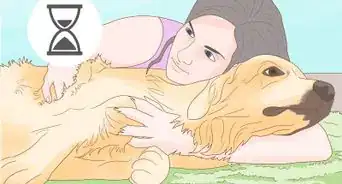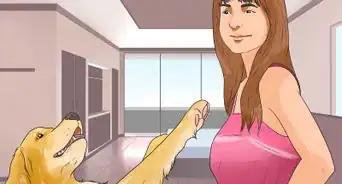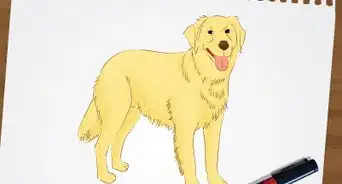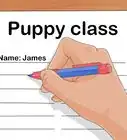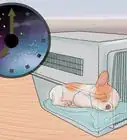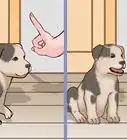This article was co-authored by Beverly Ulbrich. Beverly Ulbrich is a Dog Behaviorist and Trainer and the Founder of The Pooch Coach, a private dog training business based in the San Francisco Bay Area. She is a Certified CGC (Canine Good Citizen) Evaluator by the American Kennel Club and has served on the Board of Directors for the American Humane Association and Rocket Dog Rescue. She has been voted the best private dog trainer in the San Francisco Bay Area 4 times by SF Chronicle and by Bay Woof, and she has won 4 "Top Dog Blog" awards. She has also been featured on TV as a dog behavior expert. Beverly has over 18 years of dog behavior training experience and specializes in dog aggression and anxiety training. She has a Master of Business Administration from Santa Clara University and a BS from Rutgers University.
There are 18 references cited in this article, which can be found at the bottom of the page.
wikiHow marks an article as reader-approved once it receives enough positive feedback. This article received 16 testimonials and 94% of readers who voted found it helpful, earning it our reader-approved status.
This article has been viewed 483,815 times.
It’s hard not to love a golden retriever puppy. Unless she or he happens to be peeing on your floor or eating your shoes. Training your golden retriever from a young age will help form a bond between you and your dog, help to keep your dog (and your possessions) safe, and will make both you and your dog happier. There are certain things all owners will want to teach – house training and leash training as well as basic commands like “sit” and “come”. But there are dozens of other behaviors you can teach your golden retriever puppy using the same basic method.
Steps
Basic Training Methods
-
1Focus on rewarding good behavior when you see it. There are many different methods of training dogs, but the effective ones all boil to three things: rewarding behaviors you like; not rewarding behaviors you don’t like; and staying consistent.[1]
- Rewarding – This is the easy and fun part. Rewards aren’t just for when you are actively training. If your golden pees outside, you praise her/him. If she/he greets another dog in a friendly manner, tell her/him how great she/he is.
- Not rewarding negative behavior – This requires a little more vigilance. If your dog is doing something you don’t like, think about why: usually it is because she is rewarded somehow. You need to consistently remove that reward. For instance, if he/she jumps all over you in excitement when he/she sees his/her leash, you will not want to put it on and take him/her for a walk, as that rewards the behavior. Instead, turn away or look to the sky until he/she calms down. Then put the leash on and walk her.
- Be consistent – You and everyone else should respond the same way whatever your dog does. If you don’t feed her from the table, but your kid is busy offering your golden half his plate, you’re in trouble. Or if you tell your dog to get down when she jumps up sometimes and greet her enthusiastically others times, you are sending mixed messages that will confuse your dog.
-
2Use a reward your dog responds to. Whenever you are training your dog for a specific behavior, you will need to have a reward on hand. Pick something your goldie really loves; the better the reward, the easier it will be to teach your dog.[2] If your dog loves to play, you can try using her favorite toy and playing with her when she barks. Most people, however, will find that treats are the most effective way to teach a dog. The best treats will be ones your dog loves, and which are also easy to carry, easy to break into pieces, and healthy.[3] Use a variety of treats so your dog doesn’t get bored.[4] Try:[5]
- String cheese sticks.
- Cooked chicken.
- Meat rolls (available at pet stores).
- Broken-up dog biscuits or store-bought training treats.
- Baby carrots or frozen green beans (for dogs on a diet).
Advertisement -
3Consider clicker training. In clicker training, you use a sound (the clicker) to let your dog know when she has done something right. The clicker is very effective because it is a consistent, unique sound, different from your voice.[6]
- Load your clicker first. Get a treat in your hand. If your dog tries to get it, just close your hand. Click and offer it to your dog. Repeat a few minutes later. Then again. Continue until your dog comes immediately at the sound of the clicker and expects a treat.[7]
-
4Train one skill at a time and keep sessions short, simple and rewarding.[8] Effective training should be fun for you and your dog. To get the most out of it, follow these best practices:[9]
- Keep it short. Training sessions should last no more than 15 minutes, and usually less for a puppy.
- Train one part of one skill. For instance, if you are teaching sit and stay, start with sit. Reward all sitting, then add a command as your dog sits, then practice sitting on command. Next practice staying seated. Then train staying seated while you walk away. And finally move the training to a more distracting environment like a park. Breaking training down like this will make it much more effective.
- Use simple words, not sentences. You need your commands to be simple and consistent: “sit” instead of “sit, Fido” or “sit down” or “would you please sit.” The more words you use, the more confused your dog will be.
-
5Decide what you want your dog to know. All owners will want their golden retriever puppy to be house-trained as soon as possible, and most will want to leash train their puppy as well. Basic obedience training – sit, stay, come, down, and leave it – is also vital. The other tricks, skills, and behaviors that are desired will depend on the likes and dislikes of each owner and dog.
- Golden’s love to fetch, and it is a great way to exercise them, so it’s a good skill for them to learn. But you may want to teach your dog to play tug of war or catch a Frisbee instead.
- Tricks like “speak” and “shake” (or “fist bump”) are fun, but not necessary.
- If you travel or board your dog frequently, you will want to be sure she is crate trained.
- Depending on your dog’s temperament, you may have to train them not to beg, not to jump on you when you come home, or not to show aggressiveness towards other dogs (though this last is not typically a problem with golden retrievers).
Obedience Training
-
1Decide what you will teach your puppy. Obedience training consists of teaching your dog to do things in response to your verbal commands or hand signals. Basic commands like “sit”, “come”, “leave it”, and “stay” are important to help you manage your dog and ensure her safety, but there are many other commands you can teach, like “shake”, “roll over”, “jump” or “speak”. Most of these skills are taught with the same basic reward-based methods – capturing or luring – which will be demonstrated here with “sit”.
-
2Use the lure method to teach “sit”. Be sure to break up the training described here into multiple short sessions carried out over several days.
- With a treat in hand, hold your hand out so your puppy can smell it, then lift your hand up and back over her head. As her eyes follow you and her head goes up, your golden puppy will automatically sit. As soon as she does, say “yes” or click and give the treat. Do this until she is easily lured into sitting.
- Now try the same thing, but with no treat in your hand. Say “sit” and move your hand back. Give her the treat as soon as she sits.
- When your golden has mastered sitting for your empty hand, back away, and use the same hand motion at a distance while saying “sit”.
- Finally, say “sit” without the hand motion, and reward your dog when she does so.
-
3Use the capture method to teach sit. Get some treats. Ignore your puppy, but watch her closely. As soon as she sits, say “sit” and toss a treat. She will probably try all sorts of things to get another treat. Wait for her to sit again, then say “sit” and toss a treat. Your dog will quickly learn to link sitting, the word “sit” and treats.
House-Training
-
1Know when to house train your golden retriever puppy. Start house training the moment you bring the puppy home. After the journey, take pup out to your chosen toilet spot and let her sniff around. If she happens to pee or poop, give her a reward.[10] Regularly take the pup to the toilet spot (every 20 minutes when possible) and when she happens to toilet give her lots of praise. [11]
- Times when she is most likely to toilet are immediately after eating, and 20 minutes after eating. Pop her outside on both occasions and this increases your chances of her pooping in the toilet spot.
- This early stage is all about happy coincidences and rewarding them. Don't worry if she doesn't "get it" at first, but never ever punish her for going indoors.
-
2Be positive and consistent. Punishing your dog for peeing or pooping in the house will only scare her and make it harder for her to learn. Consistency is the best way to train your dog.[12]
-
3Feed your puppy on a regular schedule. Remove the food between meals. Regular feedings will lead to regular times when your dog needs to eliminate.[13]
-
4Take your puppy outside frequently on a regular schedule. A consistent schedule is the best way to avoid accidents.[14] Very young puppies should be taken out every hour, as well as shortly after meals and naps. All puppies should be taken out first thing in the morning, just before you go to bed, and before they are confined or left alone.[15]
- A puppy can usually hold her pee for the same number of hours as her age in months during the day.
- Puppies can hold their pee longer at night. A 4 month old puppy should be able to make it through the night
-
5Keep a close eye on your puppy to prevent accidents. You don’t want your puppy to get in the habit of eliminating in the house, so whenever she is not confined, watch her closely. Pacing, whining, circling, sniffing, and leaving the room are all signs that your puppy needs to pee or poop. Get her outside as quickly as possible.[16]
-
6Confine your golden retriever puppy when you can’t watch her. Use a crate or a small room with the door closed or blocked off by a baby gate. As your puppy grows, you can gradually increase the size of the area, eventually letting her use multiple rooms. Especially when first increasing the size of the space, it’s a good idea to introduce your golden to the space just after she has eliminated outside.[17]
-
7Reward your puppy when she pees or poops outside. During house training, you should always go outside with your puppy. Take her to the same place each time, so the smells will encourage her to go. Rewards peeing or pooping outside with praise, treats, or play. [18]
-
8Stay calm if you catch your puppy in the middle of an accident. You don’t want to scare your puppy, and you definitely don’t want to rub her face in the mess. Clap sharply in order to startle her; this will usually cause her to stop. Then quickly run with her outside, encouraging her to follow you. If your golden finishes peeing or pooping outside, give a reward. If she has nothing left, don’t worry about it.[19]
Leash Training
-
1Decide how trained you need your dog to be. It takes discipline, consistency, and time to teach you dog to walk at your side, never tugging on the leash or taking off to chase squirrels. But if that’s what you’re after, then you can do it. On the other hand, you may not mind if your dog walks ahead of you, so long as she doesn’t tug too hard on the lease. In this case, a no-pull harness or head halter might do the trick without any extra training. Knowing what you are aiming for – and being on the same page with anyone else who walks the dog – is key.
-
2Get the right equipment. You’ll want a four to six foot, fixed length leash. Extendable leashes and very long ones will make training more difficult. For a collar, use: a regular buckle or snap collar; a slip collar; a head halter; or a no-pull harness.[20]
- Do not use a choke collar, unless training with a professional trainer.
- Never use a pinch or prong collar, unless training with a professional trainer.
-
3Make every walk into a training session. Consistency is the key, so until your dog can walk without pulling, every walk, no matter who gives it, is a training session. Keep them short and fun. Going on a long walk with a dog who is not yet trained will only frustrate both of you.[21]
-
4Exercise your dog before leash training sessions. This is important for two reasons: 1) until your puppy is trained, your walks will be too short to fully exercise her; and 2) dogs with lots of energy are more likely to pull. Play fetch or tug, or let your dog romp with other dogs at the park before your leash training sessions.[22]
-
5Have treats on hand. You’ll need lots of them to train your dog. For walks, soft ones like cheese, cooked hot dogs, jerky, or chicken are best, since they can be eaten quickly while your dog is walking.[23]
-
6Walk quickly. Moving fast makes you more interesting to your dog, and she will be less likely to stop repeatedly if she’s moving fast. It will also be easier to teach your dog not to pull if you’re going a bit closer to her natural pace.
-
7Choose your method. There are four main methods to teach your dog not to pull. Some work better with some dogs than others. If you choose a method and appear to be making no progress after several weeks, pick another one.[24]
- Stop and go – When your dog reaches the end of the lease, stop. Wait until she puts slack in the leash, then call her to you and ask her to sit. When she does, say “yes” and give her a treat. Do this every time your dog reaches the end of the leash. Also give your dog treats regularly whenever she looks at you or walks close to you. You want her to associate walking near you with treats, and tugging with the walk stopping. If she tugs to smell something, stop as usual, but instead of giving her a treat after she sits, let her explore the scent she was going for as her reward.
- Lure and reward – Fill your left hand with treats, hold it in front of your golden retriever puppy’s nose, say “let’s walk”, and start walking. Give a treat every few seconds. If she pulls, stop and call her back to you, then reward her. Don’t go too far – these walks take lots of treats and bending over. After a week, stop luring. Say “let’s walk” and walk with your left hand held normally. Give a treat every other step. In the coming walks, gradually increase the number of steps between treats: 2, 5, 10, 20. Eventually, you should be able to walk your dog with only occasional treats.
- About face – This option is mainly for dogs that struggle with the first two methods. When your dog is nearing the end of the leash, say “easy.” If she slows, say “yes” and reward her with a treat. If she keeps going to the end, turn abruptly and head the other way, letting the leash check your dog. Praise your dog as she hurries to catch up, and when she reaches you, turn and resume walking in the original direction. Do this every time your dog pulls. When your dog is walking near you or at your side, treat her regularly.
- This method should work quickly. If pulling does not decrease after several sessions, stop.
- Do not use this method with a head halter or pinch collar, as it may injure your dog.
- Collar correction - This option is mainly for dogs that struggle with the first two methods. When your dog is nearing the end of the leash, say “easy.” If she slows, say “yes” and reward her with a treat. If she keeps going to the end, jerk abruptly on the leash. It may take several jerks to get your dog to slow down. Be sure to reward your dog regularly when she is walking near you with a slack leash.
- Be aware that pulling too hard can hurt your dog’s neck or throat.
- This method should reduce pulling in a couple of days. If it does not, you need to stop and try something else.
Crate Training
-
1Use a crate to keep your puppy, and your possessions, safe when at home and traveling. There are a variety of reasons to crate train your dog. Use your crate:[25]
- To keep your puppy safe when you cannot watch her.
- To keep your belongings safe when you cannot watch your puppy.
- When your puppy is home alone.
- To give your puppy a place to calm down.
- When traveling.
- To keep your puppy away from children or other dogs.
- To aid in house training and other behavioral training.
-
2Know what not to use the crate for. Never use your crate to punish your dog. And once your dog is no longer a puppy and can be trusted not to destroy the house, do not crate your dog when you are away. Save the crate for special times – i.e. guests in the house – and travel. For the most part, your dog should enter her crate voluntarily.[26]
-
3Choose a crate. The type of crate you use is up to personal preference, though many find that wire crates are the most durable and comfortable long-term solutions for dogs (as well as being used at most kennels where you might board your dog). The most important thing is that you get the right size crate. If it is too small, your dog will not be comfortable. If it is too large, it will provide the den-like space dogs crave.[27]
- To save money, buy a crate to use for your dog when she grows up, and use a divider to make it the appropriate size for her as a puppy.
- Your dog should be able to stand in the crate without hitting her head, to turn around comfortably, and to lie on their side with their paws stretched out.
- For a typical adult golden, a 42” crate should suffice. Also buy a divider if purchasing the crate for your puppy.
-
4Make the crate safe and comfortable. Your dog should enjoy her crate. It should provide a comfortable place for her to relax, so much so that she should choose to spend time there. Make sure to:[28]
- Put the crate in a room where you spend lots of time, so your puppy does not feel abandoned.
- Keep it a comfortable temperature: out of direct sunlight and far from fireplaces and radiators.
- Place soft bedding inside.
- Place chew toys inside to give your dog something to do.
- Cover your wire crate with a towel or crate cover. This will give it more of the den-like feel your dog craves.
-
5Teach your dog to associate the crate with good things. Before crate training, you’ll want to teach your dog that the crate is magical place of wonder that produces things she loves. If you do it well, crate training will be much easier.[29]
- Assemble your crate without your dog seeing it, prop the door open, and place treats around the entrance, just inside, and at the back. Throw some new dog toys in, too.
- Let your dog explore the crate on her own. Don’t bring attention to it. Don’t say anything if she goes inside. Let her go at her own speed.
- Every hour or so put more treats in the crate when your dog is not looking. Soon, they’ll be going into the crate on their own to check for treats. (Be sure to subtract all these treats from their daily food allowance.)
- Also start feeding your dog in the crate. At first, put the bowl just inside so they only have to poke their head in. After 2 or 3 successful feedings, move it to the middle, then all the way back.
-
6Train your dog to enter the crate for treats. Show your dog a treat and toss it in the crate. As they enter use your chosen command, such as “Crate.” When your dog enters, praise her and give another treat. Move away and wait for her to leave the crate. As she does so, use your exit cue word – “Out!” Praise but do not give a treat; you want treats to be associated with the magical crate.[30]
- Do this 10 times, take a break of a few minutes, and do it 10 more times. Always use your cue words.
- Repeat the whole ritual several times a day until your dog is happily entering the crate to fetch treats. This part of the training shouldn’t take long.
-
7Teach your dog to enter the crate on command. After tossing a treat in once or twice to warm your dog up, use your command word without a treat. If she enters, praise profusely and give a treat or two. Also praise her when she leaves.[31]
- Do this 10 times, take a break, and do it 10 more times.
- Repeat this training several times a day for two or three days, until your dog is entering and leaving the crate on command.
- If your golden puppy struggles with this step, go back to the previous one.
-
8Close the door. Ask your puppy to enter the crate and sit. Slowly close the door. If you have to bang it shut before your dog escapes, then she is not ready for this step. When the door is closed, praise and give treats, then open the door and let her leave.[32]
- Practice in sets of 10, with a break, then another set of ten.
- Gradually lengthen the time they must sit in the crate before you let them out. Do sessions of training where they wait ten seconds, then 30, 45, and a minute.[33]
-
9Move further away. When your dog can comfortably stay in the crate for a minute, you will want to start moving away while she is in the crate.
- In the first session, move only a few feet away before you come back. Move to different areas of the room and keep looking at your dog.
- Next, try training sessions where you move around the room without paying attention to your puppy.
- Add moments when you step out of the room briefly and return.
- Finally, leave the room.
-
10Leave the room. At first, stay out for only five minutes. Gradually increase the time you are gone to 30 minutes.[34]
- If your dog grows overly anxious while you are gone, return and let her out. Go back to the previous step or reduce the time you are leaving her.
- Always remove your puppies leash and collar before putting her in the crate, as they are choking hazards.[35]
-
11Crate your dog when you are away. When your dog can stay comfortably in her crate for 30 minutes, it’s time to start putting her in the crate when you leave. For a puppy, these will need to be shorter trips, as a puppy cannot be expected to go more than 3 hours or so without urinating.[36] Even when your dog is grown, you should not crate her during the day for more than 4 hours. She needs to be able to get up and stretch her legs.[37]
- Exercise your dog and give her a chewy or toy before you go.
- Vary the time you put your dog in the crate. Sometimes do it ten minutes before you go. Sometimes five. Sometimes right before you head out the door. You don’t want the crate to become a signal of abandonment.
- Don’t make a fuss when you leave. Praise your dog for entering her crate, then go.
-
12Have your dog sleep in the crate overnight. Now that your puppy is comfortable in her crate, she can sleep there overnight, but be sure you can hear her. Puppies often need to pee in the middle of the night.[38]
-
13Be patient![39] Each dog is unique when it comes to crate training. Some goldens can be trained in a week or less. More timid dogs or those with bad previous experiences may take several weeks. Don’t push your dog too fast. Make sure they are comfortable with each step before moving to the next one.[40]
Teaching Your Puppy to Fetch
-
1Start with good habits. Golden retrievers love to fetch, and it is a great way to exercise them. You probably won’t need any help getting your puppy to chase a ball or toy. But be sure to instill good habits early on to make sure they learn how to bring the toy back and drop it near you.
-
2Use two toys to teach your dog to bring the toy back. Throw one, and when your dog picks it up, show the other toy and throw it the other way. While he is chasing it, pick up the first toy.[41]
- Do this until he is accustomed to fetching and then running towards you.
- Eventually, you can call your dog without showing the second toy. If he comes, say drop it and show the second toy.
- When your dog will drop on command, you can eliminate the second toy.
-
3Attach a line to the toy if using two toys doesn’t work.[42] When your dog picks it up, shake the line and run away to encourage him to follow you.
- If he follows give a treat.
- If your dog still runs away, reel him in with the rope. Praise and reward when close.
- Don’t always throw the toy right away. Let your dog chew on it sometimes after returning. You don’t want him to think he will lose it every time he returns.
- After a few weeks, your dog should stop trying to escape with the toy.
-
4Use treats to get your dog to drop. Say “drop it” and put a treat right in front of your dog’s nose. This will get even the most stubborn dogs to give up the toy.[43]
- If your dog still won’t drop, try a more irresistible treat, like bits of bacon or cheese.
- Eventually you will not need the treat, but still give one every so often.
-
5Walk away to teach your dog to drop closer to you. Just before your dog drops the toy, say “bring it” and move away. When he reaches the place you were standing, say “drop it” and walk back to him to pick up the toy. It may take a few weeks before your dog learns to bring the toy to you.[44]
-
6Use “sit” and “stay” to keep your dog from picking the toy up when you reach for it. Tell your dog to sit and stay when he drops the toy. If your dog tries to grab it when you bend down, immediately say “no” or “uh, uh” and stand up. Eventually, your dog will figure out that if he wants to keep playing, he will have to sit and stay while you pick up the toy.[45]
- When he does hold the stay, remember to say “okay” to release him before you throw the toy again.
Expert Q&A
Did you know you can get premium answers for this article?
Unlock premium answers by supporting wikiHow
-
QuestionCan I train my puppy without a clicker?
 Beverly UlbrichBeverly Ulbrich is a Dog Behaviorist and Trainer and the Founder of The Pooch Coach, a private dog training business based in the San Francisco Bay Area. She is a Certified CGC (Canine Good Citizen) Evaluator by the American Kennel Club and has served on the Board of Directors for the American Humane Association and Rocket Dog Rescue. She has been voted the best private dog trainer in the San Francisco Bay Area 4 times by SF Chronicle and by Bay Woof, and she has won 4 "Top Dog Blog" awards. She has also been featured on TV as a dog behavior expert. Beverly has over 18 years of dog behavior training experience and specializes in dog aggression and anxiety training. She has a Master of Business Administration from Santa Clara University and a BS from Rutgers University.
Beverly UlbrichBeverly Ulbrich is a Dog Behaviorist and Trainer and the Founder of The Pooch Coach, a private dog training business based in the San Francisco Bay Area. She is a Certified CGC (Canine Good Citizen) Evaluator by the American Kennel Club and has served on the Board of Directors for the American Humane Association and Rocket Dog Rescue. She has been voted the best private dog trainer in the San Francisco Bay Area 4 times by SF Chronicle and by Bay Woof, and she has won 4 "Top Dog Blog" awards. She has also been featured on TV as a dog behavior expert. Beverly has over 18 years of dog behavior training experience and specializes in dog aggression and anxiety training. She has a Master of Business Administration from Santa Clara University and a BS from Rutgers University.
Certified Dog Trainer
-
QuestionMy parents say owning a puppy is a lot of hard work. Is this true?
 Pippa Elliott, MRCVSDr. Elliott, BVMS, MRCVS is a veterinarian with over 30 years of experience in veterinary surgery and companion animal practice. She graduated from the University of Glasgow in 1987 with a degree in veterinary medicine and surgery. She has worked at the same animal clinic in her hometown for over 20 years.
Pippa Elliott, MRCVSDr. Elliott, BVMS, MRCVS is a veterinarian with over 30 years of experience in veterinary surgery and companion animal practice. She graduated from the University of Glasgow in 1987 with a degree in veterinary medicine and surgery. She has worked at the same animal clinic in her hometown for over 20 years.
Veterinarian Yes it is. Many people compare owning a puppy to having a baby because the youngster needs constant supervision, takes a lot of clearing up after, and you have sleepless nights. Truly, getting a puppy is an utter joy but it's also a huge commitment if you are going to raise the puppy right so they grow into a happy, well-adjusted adult dog.
Yes it is. Many people compare owning a puppy to having a baby because the youngster needs constant supervision, takes a lot of clearing up after, and you have sleepless nights. Truly, getting a puppy is an utter joy but it's also a huge commitment if you are going to raise the puppy right so they grow into a happy, well-adjusted adult dog. -
QuestionHow much would it cost to get insurance for a golden retriever puppy?
 Pippa Elliott, MRCVSDr. Elliott, BVMS, MRCVS is a veterinarian with over 30 years of experience in veterinary surgery and companion animal practice. She graduated from the University of Glasgow in 1987 with a degree in veterinary medicine and surgery. She has worked at the same animal clinic in her hometown for over 20 years.
Pippa Elliott, MRCVSDr. Elliott, BVMS, MRCVS is a veterinarian with over 30 years of experience in veterinary surgery and companion animal practice. She graduated from the University of Glasgow in 1987 with a degree in veterinary medicine and surgery. She has worked at the same animal clinic in her hometown for over 20 years.
Veterinarian There is no one answer to this because there are different levels of insurance coverage (for example coverage up to $2,000 of vet bills or up to $12,000). Also, some policies pay out just for one event a year, whilst others cover the pet for life. The size of the deductible influences the cost. However, there are lots of price comparison websites where you can input the details and come up with a range of policy prices from different insurers.
There is no one answer to this because there are different levels of insurance coverage (for example coverage up to $2,000 of vet bills or up to $12,000). Also, some policies pay out just for one event a year, whilst others cover the pet for life. The size of the deductible influences the cost. However, there are lots of price comparison websites where you can input the details and come up with a range of policy prices from different insurers.
References
- ↑ https://www.aspca.org/pet-care/virtual-pet-behaviorist/dog-behavior/training-your-dog
- ↑ https://www.youtube.com/watch?v=w0TASn4OhZc
- ↑ http://www.petexpertise.com/best-dog-treats-for-training.html
- ↑ http://www.humanesociety.org/animals/dogs/tips/dog_training_positive_reinforcement.html
- ↑ http://iheartdogs.com/10-best-dog-treats-for-training-your-dog/
- ↑ https://www.aspca.org/pet-care/virtual-pet-behaviorist/clicker-training-your-pet
- ↑ https://www.aspca.org/pet-care/virtual-pet-behaviorist/clicker-training-your-pet
- ↑ Beverly Ulbrich. Dog Behaviorist & Trainer. Expert Interview. 30 January 2020.
- ↑ https://www.aspca.org/pet-care/virtual-pet-behaviorist/dog-behavior/training-your-dog
- ↑ Beverly Ulbrich. Dog Behaviorist & Trainer. Expert Interview. 30 January 2020.
- ↑ https://www.aspca.org/pet-care/virtual-pet-behaviorist/dog-behavior/house-training-your-puppy
- ↑ Beverly Ulbrich. Dog Behaviorist & Trainer. Expert Interview. 30 January 2020.
- ↑ http://www.totallygoldens.com/the-best-way-to-house-train-a-puppy-4-popular-methods/
- ↑ Beverly Ulbrich. Dog Behaviorist & Trainer. Expert Interview. 30 January 2020.
- ↑ https://www.aspca.org/pet-care/virtual-pet-behaviorist/dog-behavior/house-training-your-puppy
- ↑ https://www.aspca.org/pet-care/virtual-pet-behaviorist/dog-behavior/house-training-your-puppy
- ↑ https://www.aspca.org/pet-care/virtual-pet-behaviorist/dog-behavior/house-training-your-puppy
- ↑ https://www.aspca.org/pet-care/virtual-pet-behaviorist/dog-behavior/house-training-your-puppy
- ↑ https://www.aspca.org/pet-care/virtual-pet-behaviorist/dog-behavior/house-training-your-puppy
- ↑ https://www.aspca.org/pet-care/virtual-pet-behaviorist/dog-behavior/teaching-your-dog-not-pull-leash
- ↑ https://www.aspca.org/pet-care/virtual-pet-behaviorist/dog-behavior/teaching-your-dog-not-pull-leash
- ↑ https://www.aspca.org/pet-care/virtual-pet-behaviorist/dog-behavior/teaching-your-dog-not-pull-leash
- ↑ https://www.aspca.org/pet-care/virtual-pet-behaviorist/dog-behavior/teaching-your-dog-not-pull-leash
- ↑ https://www.aspca.org/pet-care/virtual-pet-behaviorist/dog-behavior/teaching-your-dog-not-pull-leash
- ↑ http://www.totallygoldens.com/how-to-use-a-dog-crate-when-should-you-crate-your-dog/
- ↑ http://www.humanesociety.org/animals/dogs/tips/crate_training.html
- ↑ http://www.totallygoldens.com/how-to-choose-the-right-dog-crate/
- ↑ http://www.totallygoldens.com/crate-training-your-puppy-or-dog/#Getting_Prepared
- ↑ http://www.totallygoldens.com/crate-training-your-puppy-or-dog/#Getting_Prepared
- ↑ http://www.totallygoldens.com/crate-training-your-puppy-or-dog/#Getting_Prepared
- ↑ http://www.totallygoldens.com/crate-training-your-puppy-or-dog/#Getting_Prepared
- ↑ http://www.totallygoldens.com/crate-training-your-puppy-or-dog/#Getting_Prepared
- ↑ http://www.humanesociety.org/animals/dogs/tips/crate_training.html
- ↑ http://www.totallygoldens.com/crate-training-your-puppy-or-dog/#Getting_Prepared
- ↑ http://www.totallygoldens.com/crate-training-your-puppy-or-dog/#Getting_Prepared
- ↑ http://www.humanesociety.org/animals/dogs/tips/crate_training.html
- ↑ http://www.totallygoldens.com/crate-training-your-puppy-or-dog/#Getting_Prepared
- ↑ http://www.humanesociety.org/animals/dogs/tips/crate_training.html
- ↑ Beverly Ulbrich. Dog Behaviorist & Trainer. Expert Interview. 30 January 2020.
- ↑ http://www.totallygoldens.com/crate-training-your-puppy-or-dog/#Getting_Prepared
- ↑ http://www.aspca.org/pet-care/virtual-pet-behaviorist/dog-behavior/teaching-your-dog-play-fetch
- ↑ http://www.aspca.org/pet-care/virtual-pet-behaviorist/dog-behavior/teaching-your-dog-play-fetch
- ↑ http://www.vetstreet.com/our-pet-experts/how-can-i-teach-my-dog-to-play-fetch?page=2
- ↑ http://www.aspca.org/pet-care/virtual-pet-behaviorist/dog-behavior/teaching-your-dog-play-fetch
- ↑ http://www.aspca.org/pet-care/virtual-pet-behaviorist/dog-behavior/teaching-your-dog-play-fetch
About This Article
If you want to train a golden retriever puppy, give it lots of positive reinforcement whenever it performs a behavior you like, such as doing its business outside or greeting another dog in a friendly manner. Golden retrievers respond especially well to being rewarded, so if you are consistent, you will quickly train your puppy the behaviors you prefer. Your rewards can be praise, petting, playing with a favorite toy, or offering a treat. For tips from our veterinary reviewer on disciplining behaviors you don’t like, keep reading!
